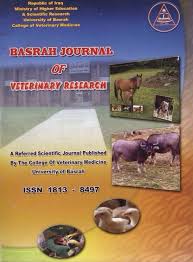Abstract
In an experimental study was designed to evaluate the immunopathological effect of sensitized Mycobacterium bovis transfer factor in guinea pigs organs against challenge infection with these microorganisms.
The results of this study were showed the followings:
1: Transfer factor recipient group:It was showed an early aggregations of macrophages and lymphocytes (early granuloma) in lungs and liver and reactive lymphoid hyperplasia and
macrophages proliferation in the paracortical region of mediastinal lymph node and in periarteriolar sheath areas in the white pulps of the spleen (T cell regions).These early granulomas were persisted during 2" and 4h week postinocultation and slightly decreased and disappeared during the 6h and 8h weeks postinoculation respectively.
2:Group of infection with Mycobacterium bovis:It was showed on extensive tubercuclous granutomatous lesions in the lungs, liver, spleen, kidneys and in the mediastinal and hepatic
lymph nodes.The lesions were initiated at 2nd week postinoculation and it gradually developed into extensive tuberculous granuloma with central caseation, during the 4h and 6h weeks
postinoculation.These lesions were persisted and continued during 8h week postinoculation. Two animals died at 7h week postinoculation due to generalized tuberculosis.
3:Transfer factor recipient group and challenged with Mycobacterium bovis. It was showed a well developed granulomatous reactions in the lungs, liver, spleen and mediastinal and hepatic lymph nodes. These granulomas consisted of aggregation of epitheliod cells, lymphocytes and few giant cells without caseastion. These granulomas were initated during the 2' week and gradually
increased in size in the 4h week and decreased at 6h week and completely disappeared during the 8th week postinoculation. No animals were died in this group. 4: Control group:It was showed neither morphological and nor histological lesions in the body organs.
The results of this study were showed the followings:
1: Transfer factor recipient group:It was showed an early aggregations of macrophages and lymphocytes (early granuloma) in lungs and liver and reactive lymphoid hyperplasia and
macrophages proliferation in the paracortical region of mediastinal lymph node and in periarteriolar sheath areas in the white pulps of the spleen (T cell regions).These early granulomas were persisted during 2" and 4h week postinocultation and slightly decreased and disappeared during the 6h and 8h weeks postinoculation respectively.
2:Group of infection with Mycobacterium bovis:It was showed on extensive tubercuclous granutomatous lesions in the lungs, liver, spleen, kidneys and in the mediastinal and hepatic
lymph nodes.The lesions were initiated at 2nd week postinoculation and it gradually developed into extensive tuberculous granuloma with central caseation, during the 4h and 6h weeks
postinoculation.These lesions were persisted and continued during 8h week postinoculation. Two animals died at 7h week postinoculation due to generalized tuberculosis.
3:Transfer factor recipient group and challenged with Mycobacterium bovis. It was showed a well developed granulomatous reactions in the lungs, liver, spleen and mediastinal and hepatic lymph nodes. These granulomas consisted of aggregation of epitheliod cells, lymphocytes and few giant cells without caseastion. These granulomas were initated during the 2' week and gradually
increased in size in the 4h week and decreased at 6h week and completely disappeared during the 8th week postinoculation. No animals were died in this group. 4: Control group:It was showed neither morphological and nor histological lesions in the body organs.
Keywords
Granuloma
Guinca pig
Transfer factor
